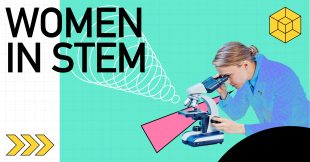
Throughout history, women have always played a crucial role within science, technology, engineering and mathematics (STEM). Though at times these contributions have been overlooked, or even forgotten, and Women in STEM week serves to celebrate the work of these pioneering individuals and make way for the STEM leaders of the future.
Equal access to education is a human right, and this applies to STEM subjects too. This, however, has not always been the case. To this day, there is a science gender gap. Less than 30% of the world’s researchers are women and this under-representation occurs in every region in the world. In schools, boys are also traditionally more likely to choose STEM subjects and to move on to studying STEM degrees at university.
On this International Day of Women and Girls in Science, physics teacher Charlotte Grace talks about why it is so important that more young women choose #STEM subjects 🙋♀🔬 #WomenInScience #GirlsinScience pic.twitter.com/92o8dIqwXy
— Department for Education (@educationgovuk) February 11, 2021
But change is coming. In the UK, there has been a 31% increase in entries from women and girls to STEM A-levels between 2010 and 2019. There has also been an increase in the number of young women taking Mathematics and Further Mathematics, by around 2.8% and 3.9% respectively.
In higher education, the picture for women in STEM looks bright. Between 2011 and 2020, the number of women accepted onto full-time STEM undergraduate courses increased by 50.1% in the UK. Within the same period, the proportion of women entering full-time undergraduate courses taking STEM subjects increased from 33.6% to 41.4%.
Overall numbers of students studying science, technology, engineering and mathematics (STEM) are rising. Yet, we know employer groups continue to point to an unmet demand for higher-level STEM skills. This issue seems particularly acute in manufacturing, construction, engineering, science and technology sectors.
These high-level skills can be accessed through apprenticeships, and we are committed to addressing the STEM gender imbalance by supporting more women into high-quality STEM apprenticeship opportunities.
In 2019/20 women accounted for 11.4% of STEM starts, up from 8.8% in 2017/18. Though these changes are small, the ripple effects this will have across science and technology industries as well as the UK economy cannot be understated.
This is why we are committed to funding several different initiatives, crucial to improving women’s access into STEM. This includes a landmark £84 million programme to improve the teaching of computing and drive up participation in computer science at GCSE and A level, particularly amongst girls.
We are also funding the Advanced Maths Premium, which aims to support schools and colleges in tackling some of the financial barriers to increase participation in post-16 maths. In addition, much investment and support has been given to Isaac Physics, an online platform of GCSE and A level physics materials developed by the University of Cambridge to increase the numbers of students (particularly from typically underrepresented backgrounds) studying physics in higher education. The platform also helps to reduce teacher workload.
Other such programmes that the government is supporting includes, Improving Gender Balance in physics, and a Gender Balance in Computing Programme to identify practical interventions that schools can implement to improve girls’ participation in computing.
We’re also working with education innovators to bring about T Levels, a new, technical alternative to A Levels. They are rolling out in a phased approach over the next three years and include a number of STEM subjects such as Engineering and Manufacturing, Digital, and Health and Science.
For women, these benefits are profound. As well as opening up a whole new world of scientific possibilities, STEM degrees offer some of the highest earnings returns for female graduates. Women studying medicine can expect to benefit by around £250k on average over their lifetime, whilst returns are almost £100k on average for maths, pharmacology and engineering graduates.